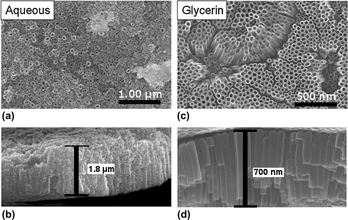Crossref Citations
This article has been cited by the following publications. This list is generated based on data provided by
Crossref.
Haring, Andrew
Morris, Amanda
and
Hu, Michael
2012.
Controlling Morphological Parameters of Anodized Titania Nanotubes for Optimized Solar Energy Applications.
Materials,
Vol. 5,
Issue. 10,
p.
1890.
Naghizadeh, Meysam
Ghannadi, Saber
Abdizadeh, Hossein
and
Golobostanfard, Mohammad Reza
2013.
Effect of Fluoride Concentration and Water Content on Morphology of Titania Nanotubes in Ethylene Glycol Solution.
Advanced Materials Research,
Vol. 829,
Issue. ,
p.
907.
Liang, Yanqin
Ma, Lili
Cui, Zhenduo
Li, Zhaoyang
Zhu, Shengli
and
Yang, Xianjin
2013.
Facile In Situ Hydrothermal Method for Synthesis of SrTiO3/TiO2Nanostructures with Improved Photoelectrochemical Activities.
Journal of The Electrochemical Society,
Vol. 160,
Issue. 10,
p.
H704.
Habiballah, Anisah Shafiqah
Mahmud, Abdul Hadi
Yazid, Hanani
and
Jani, A.M.M.
2015.
Synthesis and Morphological Characterization of Gold Nanoparticles (AuNPs) Supported on Anodized Titanium Oxide (TiO<sub>2</sub>) Nanotubes.
Materials Science Forum,
Vol. 819,
Issue. ,
p.
405.
Xue, Chaorui
Yonezawa, Tetsu
Nguyen, Mai Thanh
and
Lu, Xu
2015.
Cladding Layer on Well-Defined Double-Wall TiO2Nanotubes.
Langmuir,
Vol. 31,
Issue. 4,
p.
1575.
Erol, Mustafa
and
Bilgin, Kübra
2017.
Boron doped titaniumdioxide nanotube arrays: production, characterization and photocatalytic properties.
Journal of Porous Materials,
Vol. 24,
Issue. 5,
p.
1295.
Robinson Aguirre, O.
and
Félix Echeverría, E.
2018.
Effects of fluoride source on the characteristics of titanium dioxide nanotubes.
Applied Surface Science,
Vol. 445,
Issue. ,
p.
308.
Niu, Dongmei
Han, Aijun
Cheng, Han
Ma, Songhua
Tian, Mengmeng
and
Liu, Lin
2019.
Effects of organic solvents in anodization electrolytes on the morphology and tube-to-tube spacing of TiO2 nanotubes.
Chemical Physics Letters,
Vol. 735,
Issue. ,
p.
136776.
Aguirre Ocampo, Robinson
and
Echeverría Echeverría, Félix
2019.
Effect of the anodization parameters on TiO2 nanotubes characteristics produced in aqueous electrolytes with CMC.
Applied Surface Science,
Vol. 469,
Issue. ,
p.
994.
Batool, Syeda Ammara
Salman Maqbool, Muhammad
Javed, Muhammad Awais
Niaz, Akbar
and
Rehman, Muhammad Atiq Ur
2022.
A Review on the Fabrication and Characterization of Titania Nanotubes Obtained via Electrochemical Anodization.
Surfaces,
Vol. 5,
Issue. 4,
p.
456.
Aguirre Ocampo, Robinson
and
Echeverría Echeverría, Félix
2023.
The Effects of Anodization Conditions on TiO2 Nanotubes Features Obtained Using Aqueous Electrolytes with Xanthan Gum.
Inventions,
Vol. 8,
Issue. 5,
p.
109.
